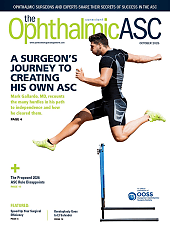Today, real innovation doesn’t happen in silos. In ophthalmology, especially, some of the most meaningful breakthroughs are the result of deep, sustained collaboration. Advancing patient outcomes requires more than internal ingenuity—it demands active partnerships with those who live and breathe the challenges of vision care every day.
From Product-Centric to Ecosystem-Centric Thinking
Earlier in our careers, collaboration in medtech was often transactional: a product demo, a clinical evaluation, or a late-stage request for feedback. Today, it’s something far more integrated and strategic. The most impactful collaborations now begin long before a prototype exists and extend well beyond commercialization.
We no longer view external partners as validators of a product—we see them as co-creators of value. From bioengineers and surgeons to academic institutions and advocacy groups, our collaborators help shape product design, surgical techniques, scientific discourse, and global access.
This shift toward ecosystem-centric innovation has become critical for 2 reasons:
- The increasing complexity of ophthalmic interventions, especially with the integration of imaging, laser, and AI technologies.
- The need for agility—not just in bringing solutions to market, but in generating credible, real-world evidence that drives adoption and reimbursement across varied healthcare systems.
Choosing Partners for Impact, Not Just Prestige
Selecting the right partners isn’t about name recognition—it’s about relevance. We actively monitor clinical literature, conference presentations, and emerging trends to identify thought leaders who aren’t just credible but are actively pushing the field forward.
We look for more than technical excellence. The most powerful collaborations happen when institutions or individuals are given the freedom to pursue truly novel approaches. That means autonomy in study design, support for unconventional methodologies, and—critically—backing their work with resources, not restrictions.
One of our most meaningful collaborations has been with Professor David Steele and his team of bioengineers. Their advanced methodologies helped us better understand the performance of our vitrectomy technology—producing data with the precision and scientific rigor needed to resonate with both clinical and regulatory audiences.
Surgeon Voices at the Core of Development
Equally critical to innovation are the practicing surgeons who operate at the intersection of clinical need and practical constraint. Their voices are a constant source of insight—and our responsibility is to listen and act.
We create regular touchpoints for engagement: OR visits, global congresses, advisory boards, and one-on-one sessions. These conversations often start with simple questions—“What are you seeing?” or “Where are we falling short?”—but frequently lead to formal R&D exploration.
What sets successful collaborations apart is cross-functional integration. Feedback doesn’t stop at marketing. Instead, it flows across engineering, regulatory, and clinical teams to assess feasibility and transform insights into globally viable solutions.
Our glaucoma work with Dr. Malik Kahook is one example. By working together, we generated comparative data on minimally invasive laser procedures, validating clinical advantages in a format that resonated with surgeons.
Beyond Products: Strengthening the Scientific Community
Collaboration is also about how we show up in the professional community. At scientific society events and conferences, we believe companies shouldn’t just promote—they should help educate, facilitate hands-on learning, and elevate knowledge exchange. In these environments, our goal isn’t to control the message; it’s to be part of the learning process.
As collaborations multiply, so does the importance of consistency. Innovation is only as impactful as it is understandable. That’s why we ensure all messaging from educational videos and scientific articles to brochures and rep conversations is anchored in clear, well-defined product positioning.
This consistency isn’t about control. It’s about clarity. When surgeons and patients hear the same message across channels, it fosters trust in the technology and confidence in its use. That clarity is especially vital in ophthalmology, where precision is paramount and safety cannot be compromised.
Driving Access Through Purposeful Collaboration
Not all partnerships are about product development. Some are about purpose. Innovation, at its best, doesn’t stop at science; it extends to people, policy, and purpose.
As we look ahead, we see even greater potential in expanding the reach and diversity of our collaborations—geographically, technologically, and structurally. Whether it’s working with academic institutions exploring next-gen optics, NGOs solving access challenges, or other agents pushing the frontier of how we know surgery, we’re committed to building bridges beyond our walls.
In today’s ophthalmic ecosystem, collaboration is no longer optional—it’s the operating system of meaningful innovation. When done right, it brings out the best in science, in systems, and in each of us.










